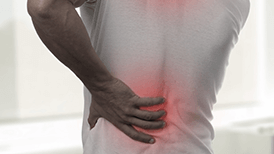Importance of Home Stretches for Lower Back Pain Relief
&srotate=0)
Low Back Pain is More Common Than You Think!
Low back pain is one of the common health problems that 50% to 80% of adults experience at some point in their life. Adults of working age, in particular, are the most vulnerable group for developing lower back pain. A surprise to many, low back pain sits at the top of the rankings for highest causes of disability over all other conditions. This is the case across the world. This means it is critical to address the concern as soon as it arises, since it has the potential to disrupt countless aspects of our daily life!
What Causes Low Back Pain?
Lower back pain often involves a muscle spasm of the muscles supporting and lining the spine; however, there are other ways it can be caused:
- The most common way is through muscle strain. Muscles of the lower back provide strength and mobility for our daily movement, so it can impact our daily living and be quite painful when these muscles are overworked or weakened.
- A secondary way that causes lower back pain is through ligament sprains from sudden, forceful movements or prolonged stress. Ligaments are critical for connecting spinal vertebrae and ensuring stability of the back. Without this stability, the lower back is more prone to carrying body weight and suffers the consequences.
- Many of us unconsciously situate ourselves in positions of poor posture, whether it be hunching over whilst working or slouching in a chair whilst relaxing. Moments such as these make an individual more prone to fatigue of the muscles, compression of the joints, and increased stress to vertebral discs. In the long term, this can cause muscles in the surrounding areas to compensate and become tight, weak, and painful.
- An unavoidable cause of lower back pain is aging. This causes a decrease in one’s bone density, their overall strength, and the elasticity of their muscles and ligaments that support the spine and associated joints. This resulting lack of support is often the explanation for back pain associated with aging.
- Lastly, there is always the potential for injuries, accidents, and conditions that result in nerve damage or damage to the spinal cord. These represent an additional pool of reasons why an individual may experience chronic back pain.
Fortunately, despite the many aforementioned reasons why an individual may experience lower back pain, there are many tips, tricks, and treatments that seek to mitigate this experienced pain.
Back Pain Prevention
It is important to take precautions to prevent back pain and any downstream issues from initiating or resurfacing. Some preventative measures include regular exercise, corrected lifting and moving techniques (such as distributing weight evenly across the body when lifting heavy loads), balanced nutrition, techniques for improving posture, and avoiding smoking.
The Science Behind Exercise for Preventing Lower Back Pain
Physical activity and aerobic exercises increase blood flow and nutrients to the back, and are vital to the healing of soft tissues and reduction of stiffness. Flexibility exercises also help to stretch soft tissues in the back, legs, buttocks, ligaments, and tendons. These mobilize the spine and increase range of motion of the spine to assist in the reduction of back pain.
It is widely supported that 30 to 40 minutes of aerobic exercise increases the body’s production of endorphins. Endorphins are endogenous hormones that are a natural alternative for pain relief in the body, thus acting like natural drugs for pain relief. These bind to the opiate receptors in the pain control system of the brain and spinal cord to decrease their perception of pain. With more endorphins, you would ideally not feel as much back pain!
In a research study where patients experiencing back pain were sorted into control and training groups, the latter set of participants were enrolled into a program with aerobic exercises that promote muscular strength and flexibility. It was found that back pain had significantly decreased by 52.5% in the training group compared to the insignificant improvements observed in the control group. Data of this sort supports the drastic effect that physical activity and stretches for lower back pain .
Important Reminders Before Exercising
- Do not go beyond your limits of stretching to force movement and pain... a slight stretch is enough.
- Proceed with the exercises below slowly and remember to breathe!
If you are interested in getting started on your pain relief journey, book your initial consultation with the doctors at Ospina Medical. Here, we can help you get back on track!
Written By: Aaliyah Sherfuddin
Edited By: Camden Rowe